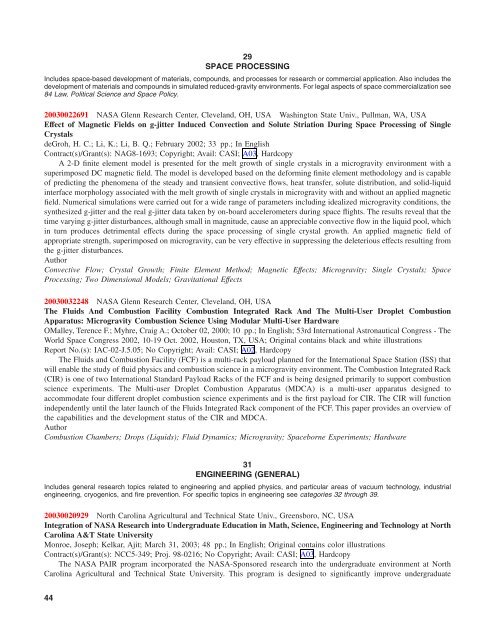Create successful ePaper yourself
Turn your PDF publications into a flip-book with our unique Google optimized e-Paper software.
29<br />
SPACE PROCESSING<br />
Includes space-based development of materials, compounds, and processes for research or commercial application. Also includes the<br />
development of materials and compounds in simulated reduced-gravity environments. For legal aspects of space commercialization see<br />
84 Law, Political Science and Space Policy.<br />
20030022691 NASA Glenn Research Center, Cleveland, OH, USA Washington State Univ., Pullman, WA, USA<br />
Effect of Magnetic Fields on g-jitter Induced Convection and Solute Striation During Space Processing of Single<br />
Crystals<br />
deGroh, H. C.; Li, K.; Li, B. Q.; February 2002; 33 pp.; In English<br />
Contract(s)/Grant(s): NAG8-1693; Copyright; Avail: CASI; A03, Hardcopy<br />
A 2-D finite element model is presented for the melt growth of single crystals in a microgravity environment with a<br />
superimposed DC magnetic field. The model is developed based on the deforming finite element methodology and is capable<br />
of predicting the phenomena of the steady and transient convective flows, heat transfer, solute distribution, and solid-liquid<br />
interface morphology associated with the melt growth of single crystals in microgravity with and without an applied magnetic<br />
field. Numerical simulations were carried out for a wide range of parameters including idealized microgravity conditions, the<br />
synthesized g-jitter and the real g-jitter data taken by on-board accelerometers during space flights. The results reveal that the<br />
time varying g-jitter disturbances, although small in magnitude, cause an appreciable convective flow in the liquid pool, which<br />
in turn produces detrimental effects during the space processing of single crystal growth. An applied magnetic field of<br />
appropriate strength, superimposed on microgravity, can be very effective in suppressing the deleterious effects resulting from<br />
the g-jitter disturbances.<br />
Author<br />
Convective Flow; Crystal Growth; Finite Element Method; Magnetic Effects; Microgravity; Single Crystals; Space<br />
Processing; Two Dimensional Models; Gravitational Effects<br />
20030032248 NASA Glenn Research Center, Cleveland, OH, USA<br />
The Fluids And Combustion Facility Combustion Integrated Rack And The Multi-User Droplet Combustion<br />
Apparatus: Microgravity Combustion Science Using Modular Multi-User Hardware<br />
OMalley, Terence F.; Myhre, Craig A.; October 02, 2000; 10 pp.; In English; 53rd International Astronautical Congress - The<br />
World Space Congress 2002, 10-19 Oct. 2002, Houston, TX, USA; Original contains black and white illustrations<br />
Report No.(s): IAC-02-J.5.05; No Copyright; Avail: CASI; A02, Hardcopy<br />
The Fluids and Combustion Facility (FCF) is a multi-rack payload planned for the International Space Station (ISS) that<br />
will enable the study of fluid physics and combustion science in a microgravity environment. The Combustion Integrated Rack<br />
(CIR) is one of two International Standard Payload Racks of the FCF and is being designed primarily to support combustion<br />
science experiments. The Multi-user Droplet Combustion Apparatus (MDCA) is a multi-user apparatus designed to<br />
accommodate four different droplet combustion science experiments and is the first payload for CIR. The CIR will function<br />
independently until the later launch of the Fluids Integrated Rack component of the FCF. This paper provides an overview of<br />
the capabilities and the development status of the CIR and MDCA.<br />
Author<br />
Combustion Chambers; Drops (Liquids); Fluid Dynamics; Microgravity; Spaceborne Experiments; Hardware<br />
31<br />
ENGINEERING (GENERAL)<br />
Includes general research topics related to engineering and applied physics, and particular areas of vacuum technology, industrial<br />
engineering, cryogenics, and fire prevention. For specific topics in engineering see categories 32 through 39.<br />
20030020929 North Carolina Agricultural and Technical State Univ., Greensboro, NC, USA<br />
Integration of NASA Research into Undergraduate Education in Math, Science, Engineering and Technology at North<br />
Carolina A&T State University<br />
Monroe, Joseph; Kelkar, Ajit; March 31, 2003; 48 pp.; In English; Original contains color illustrations<br />
Contract(s)/Grant(s): NCC5-349; Proj. 98-0216; No Copyright; Avail: CASI; A03, Hardcopy<br />
The NASA PAIR program incorporated the NASA-Sponsored research into the undergraduate environment at North<br />
Carolina Agricultural and Technical State University. This program is designed to significantly improve undergraduate<br />
44
















